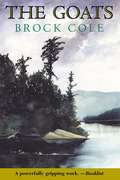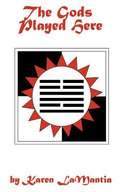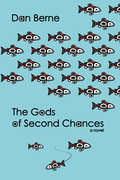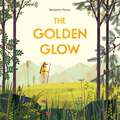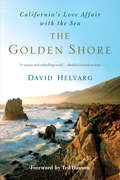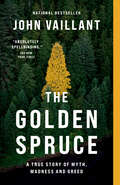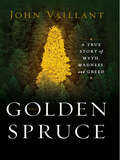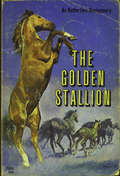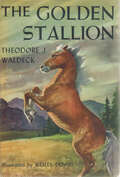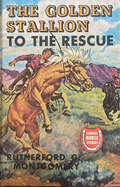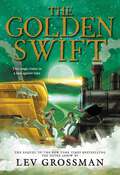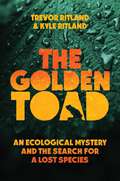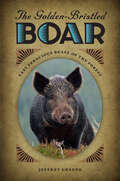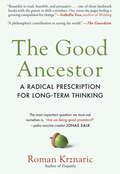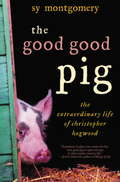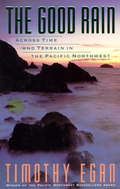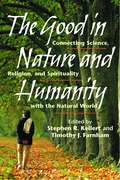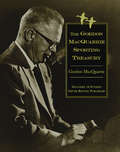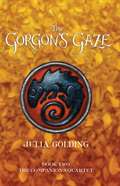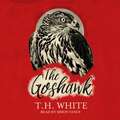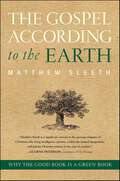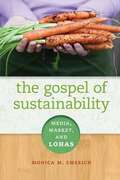- Table View
- List View
The Goats
by Brock ColeThe boy and the girl are stripped and marooned on a small island for the night. They are the "goats." The kids at camp think it is a great joke; it's an old tradition. No harm is intended, but the goats don't see it that way. They want to disappear.
The Gods Played Here and the Story of the Seven Beans
by Karen LamantiaA humorous adventure story about humanity's response to saving the planet from our own environmental devastation.
The Gods of Second Chances
by Reid Psaltis Dan BerneFamily means everything to widowed Alaskan fisherman Ray Bancroft, raising his granddaughter with help from a multitude of gods and goddesses-not to mention rituals ad-libbed at sea by his half-Tlingit best friend. But statues and otter bone ceremonies aren't enough when Ray's estranged daughter returns from prison, her search for a safe harbor threatening everything he holds sacred.
The Golden Glow
by Benjamin FlouwWes Anderson's Fantastic Mr. Fox meets Richard Scarry's Best Word Book Ever in this stylish picture book about a quest for a rare and mysterious plant.Fox loves nature. There's nothing he enjoys more than reading about and picking flowers. One evening, he comes across a rare specimen in his old botany book -- the golden glow, a plant from the Wellhidden family, found only in the mountains . . . a plant that has yet to be described. Fascinated, Fox decides to set off on a quest in search of the mysterious golden glow. He packs his knapsack, a map, a compass, a flashlight, a sleeping bag and other items for his hike. Along the way, Fox observes many different kinds of trees and plants. He also encounters woodland friends who help him make it to the summit of the mountain. But when Fox eventually stumbles upon the object of his quest, he makes a surprising decision.With spreads of educational content interspersed throughout, The Golden Glow is a charming story that details the simple pleasures of a nature hike and celebrates observing the beauty of nature.
The Golden Shore: California's Love Affair with the Sea
by David HelvargFrom the first human settlements to the latest marine explorations, The Golden Shore tells the tale of the history, culture, and changing nature of California's coasts and ocean. David Helvarg takes the reader on both a geographic and literary journey along the state's 1,100-mile Pacific coastline, from the Oregon border to the San Diego-Tijuana international border fence and out into its whale-, seal-, and shark-rich offshore seamounts, rock isles, and kelp forests. Part history, part travelogue, part love letter, The Golden Shore captures the spirit of the California coast and its mythic place in American culture.
The Golden Snowflake
by Françoise JoosAfter mother tells Hector the story of the golden snowflake, he sets out to find it. All of the animals in the forest help, but they do not find it. They do have a good lunch and a lot of fun. ... A story guaranteed to warm your heart.
The Golden Spruce: A True Story of Myth, Madness and Greed
by John VaillantThe Golden Spruce is the story of a glorious natural wonder, the man who destroyed it, and the fascinating, troubling context in which his act took place. A tree with luminous glowing needles, the golden spruce was unique and, biologically speaking, should never have reached maturity; Grant Hadwin, the man who cut it down, was passionate, extraordinarily well-suited to wilderness survival, and to some degree unbalanced. But as John Vaillant shows, the extraordinary tree stood at the intersection of contradictory ways of looking at the world; the conflict between them is one reason it was destroyed. Taking in history, geography, science and spirituality, this book raises some of the most pressing questions facing society today. The golden spruce stood in the Queen Charlotte Islands (Haida Gwaii), an unusually rich ecosystem where the normal lines between species blur. Without romanticizing, Vaillant shows that this understanding is typified by the Haida, the native people who have lived there for millennia, and for whom the golden spruce was an integral part of their history and mythology. But seen a different way, the golden spruce stood in block 6 of Tree Farm License 39. Grant Hadwin had worked as a remote scout for timber companies. But over time Hadwin was pushed into a paradox: the better he was at his job, the more the world he loved was destroyed. On January 20, 1997, with the temperature near zero, Hadwin swam across the Yakoun River with a chainsaw. He tore into the golden spruce, leaving it so unstable that the first wind would push it over. A few weeks later, Hadwin set off in a kayak across the treacherous Hecate Strait to face court charges. He has not been heard from since.Vaillant describes Hadwin’s actions in engrossing detail, but also provides the complex environmental, political and economic context in which they took place. The Golden Spruce forces one to ask: can the damage our civilization exacts on the natural world be justified?
The Golden Spruce: A True Story of Myth, Madness and Greed
by John VaillantNATIONAL BESTSELLER • WINNER OF THE GOVERNOR GENERAL'S LITERARY AWARD FOR NON-FICTION • WINNER OF THE WRITERS&’ TRUST NON-FICTION PRIZE&“Absolutely spellbinding.&” —The New York TimesThe environmental true-crime story of a glorious natural wonder, the man who destroyed it, and the fascinating, troubling context in which this act took place. FEATURING A NEW AFTERWORD BY THE AUTHOROn a winter night in 1997, a British Columbia timber scout named Grant Hadwin committed an act of shocking violence in the mythic Queen Charlotte Islands. His victim was legendary: a unique 300-year-old Sitka spruce tree, fifty metres tall and covered with luminous golden needles. In a bizarre environmental protest, Hadwin attacked the tree with a chainsaw. Two days later, it fell, horrifying an entire community. Not only was the golden spruce a scientific marvel and a tourist attraction, it was sacred to the Haida people and beloved by local loggers. Shortly after confessing to the crime, Hadwin disappeared under suspicious circumstances and is missing to this day. As John Vaillant deftly braids together the strands of this thrilling mystery, he brings to life the ancient beauty of the coastal wilderness, the historical collision of Europeans and the Haida, and the harrowing world of logging—the most dangerous land-based job in North America.
The Golden Spruce: A True Story of Myth, Madness, and Greed
by John VaillantA tale of obsession so fierce that a man kills the thing he loves most: the only giant golden spruce on earth. When a shattered kayak and camping gear are found on an uninhabited island in the Pacific Northwest, they reignite a mystery surrounding a shocking act of protest. Five months earlier, logger-turned-activist Grant Hadwin had plunged naked into a river in British Columbia's Queen Charlotte Islands, towing a chainsaw. When his night's work was done, a unique Sitka spruce, 165 feet tall and covered with luminous golden needles, teetered on its stump. Two days later it fell. As vividly as John Krakauer puts readers on Everest, John Vaillant takes us into the heart of North America's last great forest.
The Golden Stallion
by Rutherford MontgomeryCharlie was determined to have the palomino for his very own. But Golden Boy was a wild stallion who loved his freedom. And he would fight before giving it up. Catching him wouldn’t be easy! An edition especially edited for younger readers of Rutherford Montgomery's Famous Horse Stories novel "The Capture of the Golden Stallion."
The Golden Stallion
by Theodore J. WaldeckThe clear, cold air of the mountain heights, the sense of space and freedom that is to be found in the peaks of the Sierras and their valleys, the thundering beauty and intelligence of wild horses--all this, and more, is to be found in The Golden Stallion, the first book with a North American background to be written by Theodore Waldeck, famous explorer and author of African and South American jungle stories. Young Bob, brought up by his rancher father to know and love horses, lives for the day when he can have one of his very own. Golden Blaze is the name he gives the beautiful wild horse which is captured for him, and their adventures together, with a surprise ending, form this thrilling story of life in the American West, a story which adds to Mr. Waldeck’s firmly established reputation for taking his readers on stimulating adventures.
The Golden Stallion to the Rescue: Golden Stallion #3 (Famous Horse Stories)
by Rutherford MontgomeryWhen Charley Carter’s mother tries to make some much-needed money for the family by inviting boys to spend the summer at the Bar L Ranch, Rodney, a boy with a passion for geology, is the only one who comes. As he learns about working on the ranch, he spends long periods of time alone, and more time visiting Golden Boy, the beautiful once-wild stallion who keeps the ranch’s mares together. But soon Charley discovers Rodney has a plan for his rich father, an oil man, to drill for oil in the wild mountain country, and Rodney arranges to buy Golden Boy and move him East. It looks like the Carters will lose their ranch and everything they value. Worse, Golden Boy is being left to die by Rodney’s horse trainer who believes the horse is a killer. Can Charley save his life and bring him home?
The Golden Swift (The Silver Arrow)
by Lev GrossmanIn this thrilling adventure in the New York Times bestselling Silver Arrow series, Kate and Tom must confront the limits of what even magic can do—all while trying to bring balance back to the world. A lot has changed for Kate in a year. She and Tom are now full-fledged conductors of the steam-powered, animal-saving Great Secret Intercontinental Railway. Life is good! Or good-ish, anyway. Her uncle Herbert has gone missing, and the worsening climate means that there are more and more animals that need help all the time. How many times does Kate have to save the world before it stays saved? And her real life isn&’t exactly perfect either. She flunked her audition for the junior high musical and got stuck in the chorus, while her archenemy Jag got a lead. So, out of desperation, Kate breaks the rules and takes the Silver Arrow out on an unsanctioned mission, to find Uncle Herbert and bring back balance to the world. But she quickly discovers she&’s not the only one on the Great Secret Intercontinental Railway. There&’s a mysterious train called the Golden Swift out there too, with an agenda of its own. Is it an ally? A rival? An enemy? A bit of all three? The question will turn Kate&’s world upside down, take her from the Scottish Highlands to the Australian outback to the bottom of the Bering Sea, and lead her straight on a collision course with the mysterious masters of the Great Secret Intercontinental Railway itself. Because when you're a human being fighting to save nature, are you the hero or are you the villain? There are no simple answers.
The Golden Toad: An Ecological Mystery and the Search for a Lost Species
by Trevor Ritland Kyle RitlandThe Costa Rican cloud forest, a mysterious amphibian killer, and a vanished species: with support from Leonardo DiCaprio&’s Re:wild campaign, twin documentarians and environmental writers follow their father&’s footsteps into the heart of the modern extinction crisis. As young boys, Trevor and Kyle Ritland were fascinated by the magnificent golden toad of Costa Rica, a brilliant species their biologist father showed them in his projector&’s slide shows. Native to only one wind-battered ridgeline high on the continental divide above the cloud forests of Monteverde, thousands of golden toads would congregate for a few weeks each year in ephemeral pools among the twisted roots to mate, deposit their offspring, and retreat again beneath the earth. But from one year to the next, the toads disappeared without a trace; the last of them vanished more than thirty years ago. Since then, only rumors remain—alleged sightings by local residents, which beg the question: could the golden toad still be alive? In The Golden Toad, Trevor and Kyle set off to investigate an environmental mystery with unexpected revelations, a story that speaks to our own collective and uncertain future. Guided by Costa Rican naturalists—including the last person to have seen the golden toad alive—Trevor searches for survivors while Kyle hunts the killer, and their paths lead them through an imperiled forest, a deadly pandemic, and a changing climate, finally intertwining at the site of the golden toad&’s last emergence deep in Monteverde&’s Bosque Eterno de Los Niños. The toad&’s demise becomes a haunting foretelling of approaching ecological crisis, but with a gold lining on the horizon. The Golden Toad changes the conversation around extinction, climate change, and conservation while exploring environmental grief, resurrection, and hope in a changing world.
The Golden-Bristled Boar: Last Ferocious Beast of the Forest
by Jeffrey GreeneThe wild boar appears to us as something straight out of a myth. But as Jeffrey Greene learned, these creatures are very real, living by night and, despite shrinking habitats and hordes of hunters, thriving on six continents. Greene purchased an eighteenth-century presbytery in a region of ponds and forests in northern Burgundy between the Loire and Seine Rivers of France. He soon discovered he’d moved to one of the most densely populated boar areas in Europe. Following the gift of a side of boar from a neighbor, and a dramatic early-morning encounter with a boar-hunting party and its prey, Greene became fascinated with the animal and immersed himself in the legend and the reality of the wild boar. Although it has no natural enemies, the boar is in constant conflict with humans. Most societies consider it a pest, not only wreaking havoc on crops and livestock, but destroying golf-course greens in search of worms, even creating a hazard for drivers (hogs on the roads cause over 14,000 car accidents a year in France). It has also been the object of highly ritualized hunts, dating back to classical times.The animal’s remarkable appearance--it can grow larger than a person, and the males sport prominent tusks, called "whetters" and "cutters"--has inspired artists for centuries; its depictions range from primitive masks to works of high art such as Pietro Tacca’s Porcellino and paintings by Velázquez and Frans Snyders. The boar also plays a unique role in myth, appearing in the stories of Hercules and Adonis as well as in the folktale Beauty and the Beast.The author’s search for the elusive animal takes him to Sardinia, Corsica, and Tuscany; he even casts an eye to the American South, where he explores the boar’s feral-pig counterparts and descendents. He introduces us to a fascinating cast of experts, from museum curators and scientists to hunters and chefs (who share their recipes) to the inhabitants of chateaux who have lived in the same ancient countryside with generations of boars. They are all part of a journey filled with wonders and discoveries about these majestic animals the poet Robinson Jeffers called "beautiful monsters."
The Good Ancestor: A Radical Prescription For Long-term Thinking
by Roman KrznaricFrom leading philosopher Roman Krznaric, an urgent call to save ourselves and our planet by getting to the root of the current crisis—society’s extreme short-sightedness As heard on NPR’s TED Radio Hour When Jonas Salk developed the polio vaccine, he refused to patent it—forgoing profit so that more lives could be saved. His radical generosity to future generations should inspire us, but leading philosopher Roman Krznaric sees the opposite happening: Our short-term, exploitative mindsets have “colonized the future,” leaving an inexcusable chasm between the haves and have-nots—and mounting existential threats—that have brought our species to the precipice of disaster. Yet Krznaric sees reason to hope. The urgent struggle for intergenerational justice calls for hugely ambitious solutions, from rewiring our growth-at-all-costs economy to giving voters of future generations a voice in our democracies. But at the heart of all these changes is one we can enact within ourselves: We must trade shortsightedness for long-term thinking. In The Good Ancestor, Krznaric reveals six practical ways we can retrain our brains to think of the long view and to shift our allegiance from this generation to all humanity—to save our planet and our future.
The Good Good Pig: The Extraordinary Life of Christopher Hogwood
by Sy Montgomery“Christopher Hogwood came home on my lap in a shoebox. He was a creature who would prove in many ways to be more human than I am.”–from The Good Good PigA naturalist who spent months at a time living on her own among wild creatures in remote jungles, Sy Montgomery had always felt more comfortable with animals than with people. So she gladly opened her heart to a sick piglet who had been crowded away from nourishing meals by his stronger siblings. Yet Sy had no inkling that this piglet, later named Christopher Hogwood, would not only survive but flourish–and she soon found herself engaged with her small-town community in ways she had never dreamed possible. Unexpectedly, Christopher provided this peripatetic traveler with something she had sought all her life: an anchor (eventually weighing 750 pounds) to family and home.The Good Good Pig celebrates Christopher Hogwood in all his glory, from his inauspicious infancy to hog heaven in rural New Hampshire, where his boundless zest for life and his large, loving heart made him absolute monarch over a (mostly) peaceable kingdom. At first, his domain included only Sy’s cosseted hens and her beautiful border collie, Tess. Then the neighbors began fetching Christopher home from his unauthorized jaunts, the little girls next door started giving him warm, soapy baths, and the villagers brought him delicious leftovers. His intelligence and fame increased along with his girth. He was featured in USA Today and on several National Public Radio environmental programs. On election day, some voters even wrote in Christopher’s name on their ballots.But as this enchanting book describes, Christopher Hogwood’s influence extended far beyond celebrity; for he was, as a friend said, a great big Buddha master. Sy reveals what she and others learned from this generous soul who just so happened to be a pig–lessons about self-acceptance, the meaning of family, the value of community, and the pleasures of the sweet green Earth. The Good Good Pig provides proof that with love, almost anything is possible.From the Hardcover edition.
The Good Rain: Across Time and Terrain in the Pacific Northwest (Vintage Departures)
by Timothy EganTimothy Egan describes his journeys in the Pacific Northwest through visits to salmon fisheries, redwood forests and the manicured English gardens of Vancouver. Here is a blend of history, anthropology and politics.
The Good in Nature and Humanity: Connecting Science, Religion, and Spirituality with the Natural World
by Stephen R. Kellert Timothy FarnhamScientists, theologians, and the spiritually inclined, as well as all those concerned with humanity's increasingly widespread environmental impact, are beginning to recognize that our ongoing abuse of the earth diminishes our moral as well as our material condition. Many people are coming to believe that strengthening the bonds among spirituality, science, and the natural world offers an important key to addressing the pervasive environmental problems we face.The Good in Nature and Humanity brings together 20 leading thinkers and writers -- including Ursula Goodenough, Lynn Margulis, Dorion Sagan, Carl Safina, David Petersen, Wendell Berry, Terry Tempest Williams, and Barry Lopez -- to examine the divide between faith and reason, and to seek a means for developing an environmental ethic that will help us confront two of our most imperiling crises: global environmental destruction and an impoverished spirituality. The book explores the ways in which science, spirit, and religion can guide the experience and understanding of our ongoing relationship with the natural world and examines how the integration of science and spirituality can equip us to make wiser choices in using and managing the natural environment. The book also provides compelling stories that offer a narrative understanding of the relations among science, spirit, and nature.Grounded in the premise that neither science nor religion can by itself resolve the prevailing malaise of environmental and moral decline, contributors seek viable approaches to averting environmental catastrophe and, more positively, to achieving a more harmonious relationship with the natural world. By bridging the gap between the rational and the religious through the concern of each for understanding the human relation to creation, The Good in Nature and Humanity offers an important means for pursuing the quest for a more secure and meaningful world.
The Gordon MacQuarrie Sporting Treasury
by Gordon MacquarrieWe are delighted to announce that the Gordon MacQuarrie literary legacy continues: This new treasury draws 20 of the very best ODHA stories appearing in Willow Creek's Gordon MacQuarrie Trilogy and MacQuarrie Miscellany and, to ice the cake, includes 19 newly discovered stories never before published in book form.MacQuarrie became the nation's first outdoor editor in 1936.His deftly written freelance stories for the national sporting press brought him the wider attention he deserved.He has since been deemed a "master storyteller," an "artist of pace and dialogue," and "the poet laureate of duck hunting," while the Washington Post deems his tales of the Old Duck Hunters Association "masterpieces you can read over and over."Mac is truly an icon of American sporting literature and we are proud to have been his publisher for these past twenty years.
The Gorgon's Gaze (Companions Quartet #2)
by Julia GoldingMailins Wood is home to the last surviving gorgon, and Col's mother, the gorgon's Companion, is determined to save it from encroaching development--even to the point of endangering Col and his best friend Connie, the most powerful Companion alive.
The Goshawk: With a new foreword by Helen Macdonald
by T. H. White'No hawk can be a pet. There is no sentimentality. In a way, it is the psychiatrist's art. One is matching one's mind against another mind with deadly reason and interest. One desires no transference of affection, demands no ignoble homage or gratitude. It is a tonic for the less forthright savagery of the human heart.'First published in 1951, T.H. White's memoir describes with searing honesty his attempt to train a wild goshawk, a notoriously difficult bird to master. With no previous experience and only a few hopelessly out-of-date books on falconry as a guide, he set about trying to bend the will of his young bird Gos to his own. Suffering setback after setback, the solitary and troubled White nonetheless found himself obsessively attached to the animal he hoped would one day set him free.Read by Simon Vance(p) 2015 Blackstone Audio
The Gospel According to the Earth: Why the Good Book Is a Green Book
by Matthew Sleeth“Matthew Sleeth is a significant convert in the growing company of Christians who bring intelligence, passion, a biblically trained imagination, and mature Christian witness to the care of creation.” — Eugene Peterson, Author of Living the Message“Matthew Sleeth is a breath of fresh air. In The Gospel According to the Earth, he retells the Bible’s most familiar stories in ways that will stimulate your imagination, soften your heart, and challenge you to think more deeply about caring for creation.” Jonathan Merritt, author of Green Like God From Dr. Matthew Sleeth, the leading Christian voice for the green movement, comes a dynamic and surprising primer on all the Bible teaches on caring for the earth— and an ideal companion volume to The Green Bible.
The Gospel of Climate Skepticism: Why Evangelical Christians Oppose Action on Climate Change
by Robin Globus VeldmanWhy are white evangelicals the most skeptical major religious group in America regarding climate change? Previous scholarship has pointed to cognitive factors such as conservative politics, anti-science attitudes, aversion to big government, and theology. Drawing on qualitative fieldwork, The Gospel of Climate Skepticism reveals the extent to which climate skepticism and anti-environmentalism have in fact become embedded in the social world of many conservative evangelicals. Rejecting the common assumption that evangelicals’ skepticism is simply a side effect of political or theological conservatism, the book further shows that between 2006 and 2015, leaders and pundits associated with the Christian Right widely promoted skepticism as the biblical position on climate change. The Gospel of Climate Skepticism offers a compelling portrait of how during a critical period of recent history, political and religious interests intersected to prevent evangelicals from offering a unified voice in support of legislative action to address climate change.
The Gospel of Sustainability: Media, Market and LOHAS
by Monica M. EmerichFrom organic produce and clothing to socially conscious investing and eco-tourism, the lifestyles of health and sustainability, or LOHAS, movement encompasses diverse products and practices intended to contribute to a more sustainable lifestyle for people and the planet. In The Gospel of Sustainability, Monica M. Emerich explores the contemporary spiritual expression of this green cultural shift at the confluence of the media and the market. This is the first book to qualitatively study the LOHAS marketplace and the development of a discourse of sustainability of the self and the social and natural worlds. Emerich draws on myriad sources related to the notions of mindful consumption found throughout the LOHAS marketplace, including not just products and services but marketing materials, events, lectures, regulatory policies, and conversations with leaders and consumers. These disparate texts, she argues, universally project a spiritual message about personal and planetary health that is in turn reforming capitalism by making consumers more conscious.
